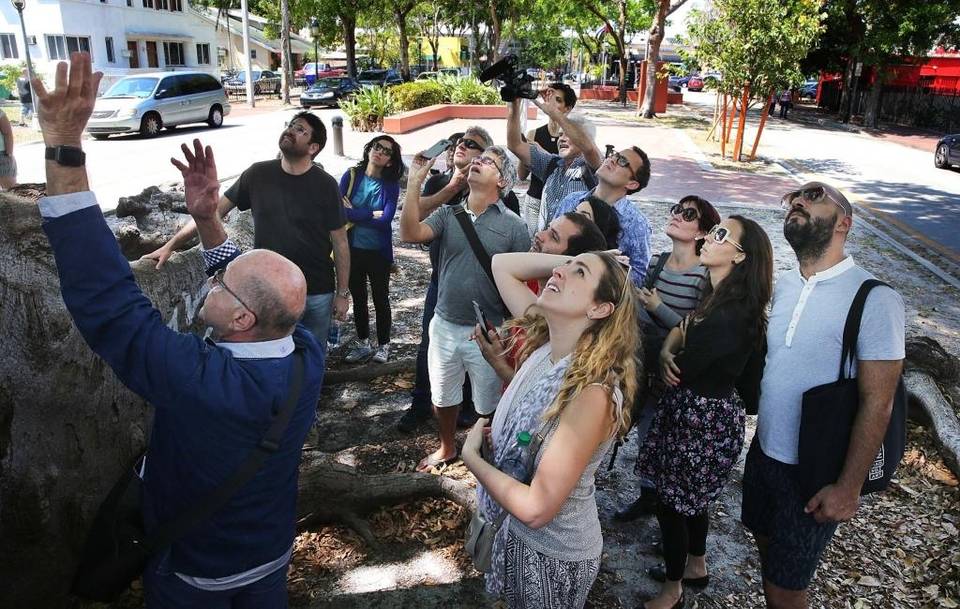April 26, 2016
BY JORDAN LEVIN
jlevin@miamiherald.com
Miami Herald
Artist Juana Valdés stands at the door of the Fountainhead Studios in Miami’s Little River district, greeting a stream of her counterparts from Cuba with smiles and kisses. “How lovely you all are!” Valdés says animatedly, leading the group to her studio, where she offers orange juice and pastelitos. She also offers a long explanation of her installation of ceramic dishes and figurines whose complex background — involving colonialism, the relationship between individual and society, how commodities are valued and much more — is further complicated when Valdés’ mostly fluent Spanish trips over words like “race,” “borders” and “commodity,” prompting friendly and confused debate.
“Comfort?” offers Inti Hernández, one of the Cuban visitors. “Roots?” suggests another.
Hernández and 14 other Cuban artists and curators are in Miami for Dialogues in Cuban Art, an exchange project organized by Miami curator Elizabeth Cerejido and sponsored by the John S. and James L. Knight Foundation and collector Jorge Pérez. Their visit, which began April 20, and culminates in a two-day symposium at the Pérez Art Museum Miami on Thursday and Friday, may not have the political heft of President Barack Obama’s trip to Cuba last month, or the celebrity visibility of Usher and Smokey Robinson’s recent Havana visit. But these artists’ Miami stay, packed with new experiences, revelations, emotional and conceptual connections and efforts to understand a foreign art world, is a kind of microcosm for the complicated integration taking place between the island and the capital of the Cuban diaspora.
“For me as a person from a country that needs to find a way to open up to the international arena and welcome all experiences and opinions, it is very meaningful,” Hernández says. “For me and for everybody.”
Hernández, who has lived in the Netherlands for a decade, and others in this group — many of whom have worked or studied abroad — are far better acquainted with the world outside Cuba than the vast majority of its residents. “Since I was little I wanted to know the world,” says Glenda León, another Cuban artist. Yet while León has lived and studied in Europe and traveled several times to Miami, this trip — crammed with visits to studios, museums, collections, dinners at people’s homes and a ceaseless flow of formal and informal talk — is far more revealing.
Valdés, who is Cuban-American, was part of the Dialogue project’s first phase, which brought seven Cuban-American artists to Havana last May. She is familiar with her visitors’ situation at home — which sparks a debate on the phrase “live-work.” A real estate catch phrase in Miami is a practical reality in Havana, where lack of space, money and commercial galleries means most artists work, display and sell their art at home. “I dream of space to do installations,” León says.
But Valdés, whose studio is in an area filling with galleries and artists fleeing the commercialization in Wynwood, sees the Cubans’ situation differently. “When gentrification happens in Havana, they won’t be as displaced as we are,” she says.
Next stop is the The Margulies Collection in Wynwood, where Cerejido has paid $25 a head for a guided tour. The centerpiece is a new exhibit of works by German artist Anselm Keifer, mostly massive pieces like a pair of towering, rough concrete structures, which resemble some of the decaying buildings in Havana. But the Cubans keep wandering off into this artistic wonderland. Lázaro Saavedra, a leading figure from Cuba’s politically and conceptually rebellious “’80s Generation,” photographs pieces from odd angles: the shadows cast by an Isamu Noguchi sculpture, down a hollow pipe in a Richard Serra piece.
“I’m looking for a point of view that’s out of the ordinary,” he says.
Felipe Dulzaides was captivated by Susan Philipsz’ installation Part File Score, where blow-ups of scores by Austrian composer Hanns Eisler are covered by FBI reports on Eisler, who fled the Nazis for the United States and was investigated for his communist politics. For Dulzaides, the piece echoes his own work inspired by his father, also Felipe Dulzaides, who played and promoted jazz in Cuba when it was politically suspect.
“You don’t escape the system,” Dulzaides says. “I’m working on the same issues of music and misunderstanding. There’s an emotional parallel in the sense of what artists go through. … It’s interesting how societies overcome those things and how important it is to talk about them.”
The possibility of such moments is what inspired Cerejido to create the Dialogues project two years ago. While she was worried about whether the project still mattered amid the growing flood of interaction with Cuba, Cerejidos has been surprised and gratified at her guests’ reactions to a piece by legendary Cuban-American avant-garde artist Ana Mendieta, nestled in the roots of a ceiba tree in Little Havana; or their wonder at the wealth of uncensored history in the Cuban Heritage Collection at the University of Miami.
“They were amazed that a neutral space like that exists in the diaspora,” says Cerejidos, standing at the coffee counter of El Palacio de Los Jugos on West Flagler Street, a homey exile landmark she has visited since she was a little girl and where she has brought the artists for lunch. She is smiling, but her eyes are bright with moisture. “I could cry about it. It reinforced to me that this is still meaningful. I was asking myself ‘Are these things still relevant? Yes, they are’.”
Sitting in El Palacio’s bustling outdoor patio, echoing with Cuban-accented Spanish, Saavedra is confronting some of the personal angles of this trip. His cousin, who recently made the dangerous trek from Cuba through Central America to Miami, has met him here for lunch. Next their group goes to the studio of José Bedia, possibly Miami’s most famous exile artist, and a friend from Saavedra’s generation whom he hasn’t seen in over 20 years. Asked why he didn’t also leave, Saavedra shrugs.
“They decided to leave,” he says. “I didn’t decide to stay. What am I going to tell you? There are no words for this — there’s too much emotion.”









